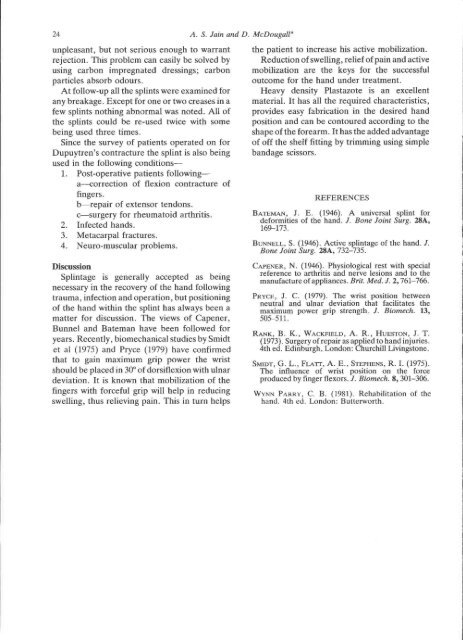View Complete Issue PDF
View Complete Issue PDF
View Complete Issue PDF
You also want an ePaper? Increase the reach of your titles
YUMPU automatically turns print PDFs into web optimized ePapers that Google loves.
unpleasant, but not serious enough to warrant<br />
rejection. This problem can easily be solved by<br />
using carbon impregnated dressings; carbon<br />
particles absorb odours.<br />
At follow-up all the splints were examined for<br />
any breakage. Except for one or two creases in a<br />
few splints nothing abnormal was noted. All of<br />
the splints could be re-used twice with some<br />
being used three times.<br />
Since the survey of patients operated on for<br />
Dupuytren's contracture the splint is also being<br />
used in the following conditions—<br />
1. Post-operative patients following—<br />
a—correction of flexion contracture of<br />
fingers.<br />
b—repair of extensor tendons.<br />
c—surgery for rheumatoid arthritis.<br />
2. Infected hands.<br />
3. Metacarpal fractures.<br />
4. Neuro-muscular problems.<br />
Discussion<br />
Splintage is generally accepted as being<br />
necessary in the recovery of the hand following<br />
trauma, infection and operation, but positioning<br />
of the hand within the splint has always been a<br />
matter for discussion. The views of Capener,<br />
Bunnel and Bateman have been followed for<br />
years. Recently, biomechanical studies by Smidt<br />
et al (1975) and Pryce (1979) have confirmed<br />
that to gain maximum grip power the wrist<br />
should be placed in 30° of dorsiflexion with ulnar<br />
deviation. It is known that mobilization of the<br />
fingers with forceful grip will help in reducing<br />
swelling, thus relieving pain. This in turn helps<br />
the patient to increase his active mobilization.<br />
Reduction of swelling, relief of pain and active<br />
mobilization are the keys for the successful<br />
outcome for the hand under treatment.<br />
Heavy density Plastazote is an excellent<br />
material. It has all the required characteristics,<br />
provides easy fabrication in the desired hand,<br />
position and can be contoured according to the<br />
shape of the forearm. It has the added advantage<br />
of off the shelf fitting by trimming using simple<br />
bandage scissors.<br />
REFERENCES<br />
BATEMAN, J. E. (1946). A universal splint for<br />
deformities of the hand. J. Bone Joint Surg. 28A,<br />
169-173.<br />
BUNNELL, S. (1946). Active splintage of the hand. J.<br />
Bone Joint Surg. 28A, 732-735.<br />
CAPENER, N. (1946). Physiological rest with special<br />
reference to arthritis and nerve lesions and to the<br />
manufacture of appliances. Brit. Med. J. 2,761-766.<br />
PRYCE, J. C. (1979). The wrist position between<br />
neutral and ulnar deviation that facilitates the<br />
maximum power grip strength. J. Biomech. 13,<br />
505-511.<br />
RANK, B. K., WACKFIELD, A. R., HUESTON, J. T.<br />
(1973). Surgery of repair as applied to hand injuries.<br />
4th ed. Edinburgh, London: Churchill Livingstone.<br />
SMIDT, G. L., FLATT, A. E., STEPHENS, R. I. (1975).<br />
The influence of wrist position on the force<br />
produced by finger flexors. J. Biomech. 8, 301-306.<br />
WYNN PARRY, C. B. (1981). Rehabilitation of the<br />
hand. 4th ed. London: Butterworth.
















